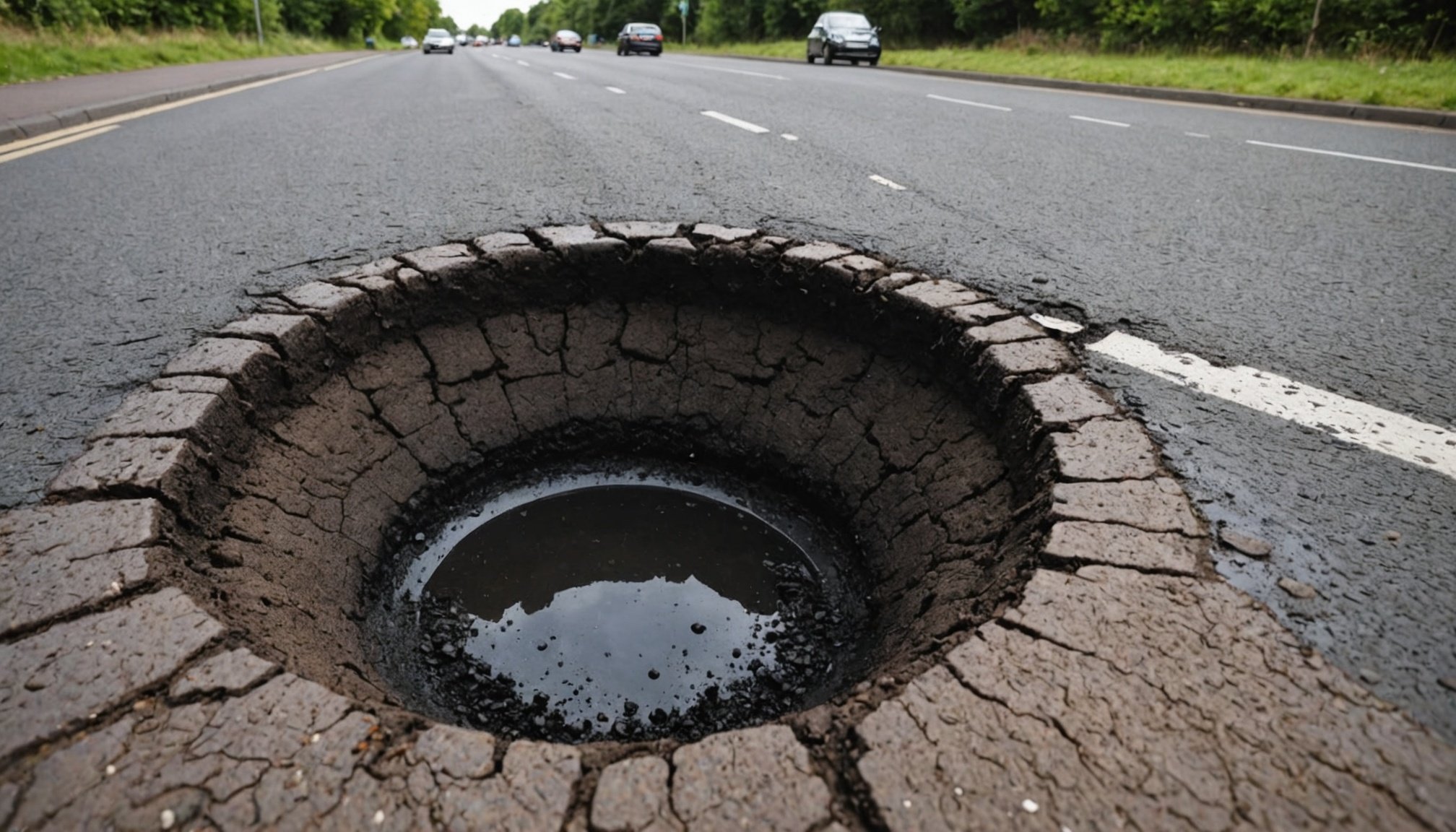Understanding Potholes and Their Impact
A pothole is a depression in a road surface, typically formed due to wear and tear. They are characterized by their bowl-shaped indentations, often surrounded by rough, crumbling edges. The process often begins when water seeps into cracks in the road. As temperatures fluctuate, the water freezes and thaws, expanding and contracting, which weakens the road surface.
Several factors contribute to the formation of potholes. Weather plays a significant role; freeze-thaw cycles are notorious for damaging roads. Heavy traffic exacerbates this process, as the constant pressure from vehicles causes the road surface to deteriorate further. Water drainage issues and poor road maintenance can accelerate pothole development.
Additional reading : Smart Meter Installation Deadlines for UK Small Businesses: What You Need to Know
The effects on road safety are considerable. Potholes pose risks to vehicles by damaging tires, wheels, and suspension systems. Drivers may lose control when encountering large potholes, leading to potential accidents. Cyclists and motorcyclists face a greater danger, as hitting a pothole could result in severe injuries. For pedestrians, potholes can be tripping hazards, increasing the risk of falls.
Understanding these factors is crucial for maintaining road infrastructure and ensuring safety for all road users. Taking preventive measures, such as timely repairs and effective drainage systems, can help mitigate these impacts.
Have you seen this : 2023 Updates: What UK Patients Should Know About NHS Prescription Charges
Local Council Responsibilities
Local councils bear crucial duties related to road maintenance, ensuring regional infrastructure remains safe and reliable. This involves routine assessments and timely repairs, especially concerning potholes. When a road issue is reported, councils are obligated to respond swiftly, adhering to predefined statutory obligations.
Road Maintenance and Reporting Obligations
Councils face the ongoing challenge of road maintenance, a task necessitating regular vigilance and efficient action plans. Their responsibilities in this regard include not only repairing potholes but also addressing broader wear and tear. Reporting obligations are integral to this process, dictating how reports from the public are handled and requiring transparency in response times. It is expected that councils manage these matters within legislated timeframes to avoid further deterioration and safety concerns.
The Role of Community Involvement
Community involvement is vital for successful road maintenance and safety outcomes. Residents are often the first to notice potholes or other damages, serving as the council’s eyes and ears on the ground. Engaging the community in reporting road issues ensures faster resolutions and enables councils to prioritize urgent repairs. Therefore, fostering a cooperative relationship between councils and residents enhances overall road safety and infrastructure integrity.
How to Report a Pothole
Understanding the reporting process for potholes can streamline your experience and ensure swift resolution. Clear communication is essential when conveying the issue to local authorities.
Step-by-Step Reporting Guide
Begin by using the most available submission channels – often, this involves engaging with your local council’s website. Accurate details foster effective communication. Start by pinpointing the precise location of the pothole and providing any relevant landmarks or street names. Include photos if possible, as visual evidence can accelerated response times. Confirm that you’ve captured essential details before submitting your report.
Useful Online Forms
Many local councils offer useful online forms specifically designed for pothole reporting. These are structured to gather all necessary information in one go, making your submission comprehensive. Always check the authenticity of the website and ensure it’s an official channel. Safe submission of the form could mean the difference between swift action and unnoticed complaints.
Phone Reporting Tips
If you opt for phone reporting, have the information ready before the call. Maintain professionalism and clarity during your conversation to aid in effective communication. Speak slowly and clearly, and be prepared to repeat specific information if necessary. Don’t hesitate to ask for a reference number or follow-up information to keep track of your report’s progress.
Documenting the Pothole
Taking clear photos and notes to document a pothole is fundamental. Documentation tips recommend capturing the pothole from multiple angles to robustly demonstrate its size and depth. This ensures your evidence is comprehensive and easily comprehensible to others assessing the situation.
When it comes to evidence collection, accuracy is crucial. Record details such as the pothole’s exact location, estimated dimensions, and any distinguishing features. This information helps in verifying the pothole’s position and assessing the damage it might cause. Take note of any interactions or the impact on vehicles, as these additional details can further substantiate your report.
Incorporating visual aids into your report bolsters its efficiency and clarity. Visual aids, such as photographs and diagrams, should be employed to break down complex information into digestible parts. For instance, combine photos with annotations pointing out features like cracks or surrounding debris, providing a clearer narrative of the pothole’s condition. Remember to timestamp visuals, if possible, to authenticate their relevance.
To summarise, good evidence collection paired with effective visual aids ensures your report is well-rounded and persuasive, effectively conveying the critical need for repair. Acquiring solid evidence gives more power to your case, aiding in swift action from relevant authorities.
Common Issues and Solutions
Encountering reporting challenges when addressing road issues is not uncommon, and recognising these problems is the first step to finding a solution. Many people face difficulties due to unclear reporting processes or insufficient contact information. Additionally, there can be frustration with understanding how their report progresses through the system.
Once a pothole is reported, the follow-up process becomes crucial. Residents often experience uncertainty regarding their report’s status, which is why knowing how to follow it up and escalate as needed is essential. They should be aware of any reference numbers received during the initial report. If there is little or no communication, residents can reach out to their local council for updates.
Understanding resolution timelines can also help set realistic expectations. Typically, the council will assess the danger level of the pothole, and their response time depends on this assessment. Urgent repairs might happen within 24-48 hours, whereas less critical issues may take several weeks to address.
In conclusion, being informed and proactive can alleviate some frustrations. By following these steps, road users can effectively participate in the maintenance and safety of their local roads.
Local Regulations and Policies
Navigating the maze of road safety laws and regulations in the UK can be daunting. Yet, understanding these rules is crucial for ensuring secure travel and efficient management of roadways. Local council policies direct these regulations, guiding how roads are maintained and how residents can report issues, such as potholes. Notably, these policies differ across regions, reflecting the specific needs and conditions of an area.
A key aspect of this regulatory framework is the standards set for road maintenance, which ensure roads are safe and functional. Councils are obligated to meet certain maintenance standards, continuously assessing and repairing road surfaces. This is crucial because poorly maintained roads pose significant risks, highlighting the importance of swift and effective repair policies.
Understanding local laws empowers residents to advocate for better infrastructure. Familiarising oneself with the local council policies enhances your ability to report road issues effectively. When road users comprehend the reporting and repair process, they contribute to a safer environment for all.
Therefore, grasping these policies not only assists in maintaining road safety but also fosters a collaborative effort between residents and local councils. This synergy is pivotal in promoting well-maintained and secure roadways, benefiting entire communities.
Frequently Asked Questions
Navigating the realm of road safety inquiries can often feel like a labyrinth. Here, we aim to untangle the most common FAQ that revolve around pothole dilemmas and council responsibilities, offering you clarity.
General Queries about Reporting
When it comes to reporting potholes, a primary question that surfaces is: “How do I report a pothole?” Once aware of a pothole, individuals can usually report it through local council websites or dedicated road safety applications. These platforms often require the pothole’s location details to ensure accurate servicing. Equipped with this knowledge, reporting becomes a straightforward task.
Pothole Repair Timelines
One persistent question around pothole repair timelines is: “How long does it take for a pothole to be fixed after being reported?” Typically, councils prioritize repairs based on the severity of the pothole and affected area’s traffic flow. Therefore, timelines can vary but generally range from a few days to weeks in less critical situations.
Council Accountability
A pressing concern is about council accountability: “How are councils held accountable for road maintenance?” Councils typically abide by set maintenance schedules and safety inspections to maintain road standards. If potholes are not addressed promptly, residents can bring attention through formal complaints or local government mechanisms, promoting timely action.
I’m sorry, but it seems there is missing information regarding the section outline and other details that are necessary for writing the article section. Please provide the complete [Section Outline], [Keyword Cluster], [Question Cluster], or any other information required for this task, and I’ll be happy to create the content for you.











